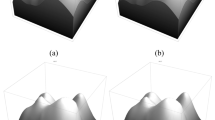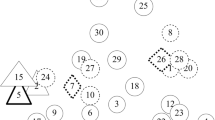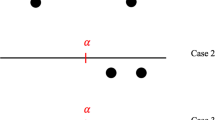Abstract
We locate a single competing facility in a particular retail category competing for customers who plan a visit to such a facility. Suppose that there is a probability that customers patronize in the same trip a second retail facility of a different category. In the standard competitive location model the probability of a multipurpose trip is zero. The estimated market share is calculated with an appropriately formulated gravity model and this is embedded in a locational decision model. An efficient implementation is devised. We show that multipurpose activity impacts all aspects of the solution: market share captured increases with this rate, and locational choices reflect an increasing interest in clustered co-location as the percentage of multipurpose trip activity increases. These results are both consistent with long standing theory and at the same time new because we are able to compute a locational trajectory for a large range of optimization scenarios. The core results hold over a wide variety of parameter variations. We solved optimally problems with up to 20,000 groups of customers in reasonable run time. The optimal location of the new facility moves from the optimal location of standard gravity models to locations close to clusters of facilities that sell different product types. At the optimal location, the market share can be more than doubled compared with the market share (including multiple trips in the calculation of the market share) captured at the location found by traditional models. Ignoring multipurpose trips results in a much inferior facility location.







Similar content being viewed by others
References
Araghi, M., Berman, O., & Averbakh, I. (2014). Minisum multipurpose trip location problem on trees. Networks, 63, 154–159.
Buffa, E. S. (1976). Operations Management: The Management of Productive Systems. Santa Barbara: Wiley & Sons.
Drezner, T. (1994). Locating a single new facility among existing unequally attractive facilities. Journal of Regional Science, 34, 237–252.
Drezner, T. (2006). Derived attractiveness of shopping malls. IMA Journal of Management Mathematics, 17, 349–358.
Drezner, T. (2019). Gravity models in competitive facility location. In H. A. Eiselt & V. Marianov (Eds.), Contributions to Location Analysis - In Honor of Zvi Drezner’s 75th Birthday (pp. 253–275). Springer.
Drezner, T., & Drezner, Z. (1996). Competitive facilities: Market share and location with random utility. Journal of Regional Science, 36, 1–15.
Drezner, T., & Drezner, Z. (1997). Replacing discrete demand with continuous demand in a competitive facility location problem. Naval Research Logistics, 44, 81–95.
Drezner, T., & Drezner, Z. (2004). Finding the optimal solution to the Huff competitive location model. Computational Management Science, 1, 193–208.
Drezner, T., & Drezner, Z. (2012). Modelling lost demand in competitive facility location. Journal of the Operational Research Society, 63, 201–206.
Drezner, T., Drezner, Z., & Kalczynski, P. (2020). A gradual cover competitive facility location model. OR Spectrum, 42, 333–354.
Drezner, T., Drezner, Z., & Salhi, S. (2002). Solving the multiple competitive facilities location problem. European Journal of Operational Research, 142, 138–151.
Drezner, T., Drezner, Z., & Zerom, D. (2018). Competitive facility location with random attractiveness. Operations Research Letters, 46, 312–317.
Drezner, T., Drezner, Z., & Zerom, D. (2020). Facility dependent distance decay in competitive location. Networks and Spatial Economics, 20, 915–934.
Drezner, Z. (1982). Competitive location strategies for two facilities. Regional Science and Urban Economics, 12, 485–493.
Drezner, Z., & Suzuki, A. (2004). The big triangle small triangle method for the solution of non-convex facility location problems. Operations Research, 52, 128–135.
Drezner, Z., & Wesolowsky, G. O. (1982). A trajectory method for the round trip location problem. Transportation Science, 16, 56–66.
Eaton, B. C., & Lipsey, R. G. (1982). An economic theory of central places. The Economic Journal, 92, 56–72.
Fernández, J., Boglárka, G., Redondo, J. L., Ortigosa, P. M., et al. (2019). The probabilistic customer’s choice rule with a threshold attraction value: Effect on the location of competitive facilities in the plane. Computers & Operations Research, 101, 234–249.
Fernández, P., Pelegrín, B., Lančinskas, A., & Žilinskas, J. (2017). New heuristic algorithms for discrete competitive location problems with binary and partially binary customer behavior. Computers & Operations Research, 79, 12–18.
Ghosh, A., & Rushton, G. (1987). Spatial Analysis and Location-Allocation Models. New York, NY: Van Nostrand Reinhold Company.
Glover, F., & Laguna, M. (1997). Tabu Search. Boston: Kluwer Academic Publishers.
Goldberg, D. E. (2006). Genetic algorithms. Delhi, India: Pearson Education.
Hakimi, S. L. (1983). On locating new facilities in a competitive environment. European Journal of Operational Research, 12, 29–35.
Hansen, P., & Mladenović, N. (1997). Variable neighborhood search for the \(p\)-median. Location Science, 5, 207–226.
Hansen, P., Peeters, D., & Thisse, J.-F. (1981). On the location of an obnoxious facility. Sistemi Urbani, 3, 299–317.
Holland, J. H. (1975). Adaptation in Natural and Artificial Systems. Ann Arbor, MI: University of Michigan Press.
Hotelling, H. (1929). Stability in competition. Economic Journal, 39, 41–57.
Huff, D. L. (1964). Defining and estimating a trade area. Journal of Marketing, 28, 34–38.
Huff, D. L. (1966). A programmed solution for approximating an optimum retail location. Land Economics, 42, 293–303.
Kalczynski, P. (2019). Cover-based competitive location models. In H. A. Eiselt & V. Marianov (Eds.), Contributions to Location Analysis - In Honor of Zvi Drezner’s 75th Birthday (pp. 277–320). Springer.
Kalczynski, P., Suzuki, A., & Drezner, Z. (2022). Multiple obnoxious facilities with weighted demand points. Journal of the Operational Research Society, 73, 598–607.
Khapugin, S., & Melnikov, A. (2019). Local search approach for the medianoid problem with multi-purpose shopping trips. In International Conference on Mathematical Optimization Theory and Operations Research, pp. 328–341.
Law, A. M., & Kelton, W. D. (1991). Simulation modeling and analysis. McGraw-Hill, New York, second edition.
Lederer, P. J. (2020). Location-price competition with delivered pricing and elastic demand. Networks and Spatial Economics, 20, 449–477.
Lee, G., & O’Kelly, M. E. (2011). Competitive location modeling with a rank proportional allocation. Environment and Planning B: Planning and Design, 38, 411–428.
Leonardi, G., & Tadei, R. (1984). Random utility demand models and service location. Regional Science and Urban Economics, 14, 399–431.
Leszczyc, P. T. P., Sinha, A., & Sahgal, A. (2004). The effect of multi-purpose shopping on pricing and location strategy for grocery stores. Journal of Retailing, 80, 85–99.
Marianov, V., Eiselt, H. A., & Lüer-Villagra, A. (2018). Effects of multipurpose shopping trips on retail store location in a duopoly. European Journal of Operational Research, 269, 782–792.
Marianov, V., Eiselt, H. A., & Lüer-Villagra, A. (2020). The follower competitive location problem with comparison-shopping. Networks and Spatial Economics, 20, 367–393.
McLafferty, S. L., & Ghosh, A. (1986). Multipurpose shopping and the location of retail firms. Geographical Analysis, 18, 215–226.
Mulligan, G. F. (1983). Consumer demand and multipurpose shopping behavior. Geographical Analysis, 15, 76–81.
Nakanishi, M., & Cooper, L. G. (1974). Parameter estimate for multiplicative interactive choice model: Least squares approach. Journal of Marketing Research, 11, 303–311.
O’Kelly, M. E. (1981). A model of the demand for retail facilities, incorporating multistop, multipurpose trips. Geographical Analysis, 13, 134–148.
O’Kelly, M. E. (1983). Impacts of multistop, multipurpose trips on retail distributions. Urban Geography, 4, 173–190.
O’Kelly, M. E. (1983). Multipurpose shopping trips and the size of retail facilities1. Annals of the Association of American Geographers, 73, 231–239.
O’Kelly, M. E. (2009). Applied retail location models using spatial interaction tools (pp. 419–442). The SAGE Handbook of Spatial Analysis. London: Sage Publications Ltd.
Peeters, P. H., & Plastria, F. (1998). Discretization results for the huff and pareto-huff competitive location models on networks. TOP, 6, 247–260.
Pelegrín, B., Fernández, P., & García, M. D. (2018). Computation of multi-facility location nash equilibria on a network under quantity competition. Networks and Spatial Economics, 18, 999–1017.
Reilly, W. J. (1931). The Law of Retail Gravitation. New York, NY: Knickerbocker Press.
Schöbel, A., & Scholz, D. (2010). The big cube small cube solution method for multidimensional facility location problems. Computers & Operations Research, 37, 115–122.
Serra, D., & ReVelle, C. (1995). Competitive location in discrete space. In Z. Drezner (Ed.), Facility Location: A Survey of Applications and Methods (pp. 367–386). New York, NY: Springer.
Suzuki, T., & Hodgson, M. J. (2005). Optimal facility location with multi-purpose trip making. IIE Transactions, 37, 481–491.
Tamir, A., & Halman, N. (2005). One-way and round-trip center location problems. Discrete Optimization, 2, 168–184.
Wendell, R. E., & Hurter, A. P. (1973). Location theory, dominance and convexity. Operations Research, 21, 314–320.
Yu, W. (2020). Robust model for discrete competitive facility location problem with the uncertainty of customer behaviors. Optimization Letters, 14, 2107–2125.
Author information
Authors and Affiliations
Corresponding author
Additional information
Publisher's Note
Springer Nature remains neutral with regard to jurisdictional claims in published maps and institutional affiliations.
Rights and permissions
Springer Nature or its licensor holds exclusive rights to this article under a publishing agreement with the author(s) or other rightsholder(s); author self-archiving of the accepted manuscript version of this article is solely governed by the terms of such publishing agreement and applicable law.
About this article
Cite this article
Drezner, T., O’Kelly, M. & Drezner, Z. Multipurpose shopping trips and location. Ann Oper Res 321, 191–208 (2023). https://doi.org/10.1007/s10479-022-04946-3
Accepted:
Published:
Issue Date:
DOI: https://doi.org/10.1007/s10479-022-04946-3




